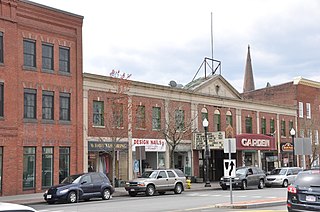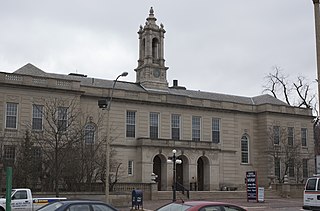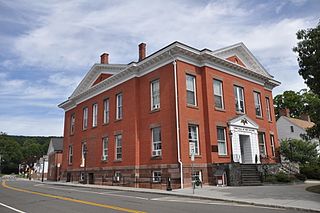
The Ashburnham Center Historic District is a historic district encompassing the core of the village center of Ashburnham, Massachusetts in the United States. It is a well-preserved industrial village that experienced its most significant period of growth in the mid-19th century. The district was added to the National Register of Historic Places in 1999.

Orange Center Historic District is a historic district encompassing the historic civic, commercial, and industrial heart of Orange, Massachusetts in the United States. It was listed on the National Register of Historic Places in 1989.

The West Gardner Square Historic District encompasses the historic commercial, civic and industrial downtown area of Gardner, Massachusetts. Developed industrially beginning in the early 19th century, the area now boasts a concentration of late 19th and early 20th century commercial, civic, and industrial architecture. It was listed on the National Register of Historic Places in 1985.

Hubbardston Town Common Historic District encompasses the town common of Hubbardston, Massachusetts, the adjacent 1773 First Parish Church, and the town's first burying ground. It has been the center of the town's civic and religious life since its incorporation in the 1760s, and was listed on the National Register of Historic Places in 2000. The district was named as one of the 1,000 Places to Visit in Massachusetts by the Great Places in Massachusetts Commission.

The North Falmouth Village Historic District encompasses the historic 19th-century village of North Falmouth, Massachusetts, which is a village in the town of Falmouth, Massachusetts. It is a linear district, extending along Old Main Road south from its junction with Massachusetts Route 28A to Winslow Road. This area gradually developed over the 19th century, principally in support of maritime activities centered on Buzzards Bay to the west. The district contains a cross-section of architectural styles popular from the early 19th to early 20th centuries. It was listed on the National Register of Historic Places in 1998.

The Leavitt–Hovey House is an historic house located at 402 Main Street in Greenfield, Massachusetts. Built in 1797, it is a prominent work of local architect Asher Benjamin, and a good local example of Federal period architecture. From 1909 to June 17, 2023, it served as the home of the Greenfield Public Library.

The South Lee Historic District encompasses the historic portion of the village of South Lee in Lee, Massachusetts. Extending mainly along Massachusetts Route 102 between Fairview Street and the Stockbridge town line, the village is a well-preserved 19th-century mill village, with fine Federal and Greek Revival buildings and a later 19th-century paper mill. It was listed on the National Register of Historic Places in 1999.

The East Main–High Street Historic District is a historic district roughly bounded by Church, High, East Main and Franklin Streets in Greenfield, Massachusetts. It encompasses a predominantly residential area just east of Greenfield's central business district, historically where the town's wealthier residents lived, and features a wide variety of mainly 19th-century residential architecture. The district was listed on the National Register of Historic Places in 1989.

The Garden Theater Block is a historic commercial block and theater at 353-367 Main Street in Greenfield, Massachusetts. The Colonial Revival block was completed in 1929, and is home to the city's largest theatrical performance venue. The theater is a unique example of an "atmospheric" garden theater, with artwork and mechanical systems designed to give its interior an outside appearance. The building was listed on the National Register of Historic Places in 1983, and included in the Main Street Historic District in 1988. The theater is now known as the Greenfield Garden Cinemas.

The New Salem Common Historic District encompasses the historic town center of New Salem, Massachusetts. Located on South Main Street, it includes the town common and most of its civic and institutional buildings. Most buildings in the district date to the 18th and 19th centuries. The district was listed on the National Register of Historic Places in 1978.

The Northampton Downtown Historic District encompasses most of the central business district of Northampton, Massachusetts. This area, which has been a center of commerce and industry in the area since colonial days, extends from the railroad tracks on the east side of the downtown, and west along Main Street to its junction with West Street and Elm Street. When the district was first listed on the National Register of Historic Places, it ended at the railroad tracks, and included properties on a number of other downtown streets; this was extended in 1985 to include a few properties just east of the railroad tracks on and near Bridge Street. The district includes such notable buildings as the 1891 Academy of Music Theatre, and Northampton's castle-like City Hall.

The Marlborough Center Historic District is a historic district encompassing the civic and commercial heart of Marlborough, Massachusetts. It is centered on a stretch of Main Street between Mechanic Street to the west and Bolton Street to the east, and includes properties on adjacent streets. The center is reflective of the city's prosperity as an industrial center from the mid-19th century to the mid-20th century. The district was listed on the National Register of Historic Places in 1998.

The Common Historic District is a historic district encompassing the civic and institutional heart of Reading, Massachusetts. The district is centered on the town common, at the intersection of Main and Salem Streets. The common has been communally owned since at least 1737, with the original burying ground to the north. In 1769 the area's first meeting house was built, giving the area a sense of identity separate from portions of Reading that would later be set off as Wakefield and North Reading. Since then the area has become a focal point for religious and civic institutions in the town.

The Arlington Center Historic District includes the civic and commercial heart of Arlington, Massachusetts. It runs along the town's main commercial district, Massachusetts Avenue, from Jason Street to Franklin Street, and includes adjacent 19th- and early 20th-century residential areas roughly bounded by Jason Street, Pleasant Street, and Gray Street. The district was listed on the National Register of Historic Places in 1974.

The Common District encompasses the main civic center of Wakefield, Massachusetts. It is centered on the historic town common, just south of Lake Quannapowitt, which was laid in 1644, when it became the heart of Old Reading. The area was separated from Reading as South Reading in 1818, and renamed Wakefield in 1868. The 25 acre district includes the buildings that line the common on Common Street and Main Street, which include the town hall, public library, YMCA, post office, and several churches. It was listed on the National Register of Historic Places in 1990.

The Nobility Hill Historic District is a residential historic district roughly bounded by Chestnut and Maple Streets and Cedar Avenue in Stoneham, Massachusetts. The district includes a number of high quality houses representing a cross section of fashionable housing built between 1860 and 1920. It was added to the National Register of Historic Places in 1990.

The West Chesterfield Historic District is a historic district that encompasses the 19th century industrial and residential heritage of the village of West Chesterfield in the town of Chesterfield, Massachusetts. Centered at the junction of Main Road and Ireland Street, it was one of the town's main industrial sites for many years. The district was listed on the National Register of Historic Places in 2008.

The Bennington Village Historic District of Bennington, New Hampshire encompasses the 19th-century center of the village. Growth of the village followed a typical pattern for rural New Hampshire towns, based in this case around the growth in the early 19th century of the paper industry, which continues to be a significant economic force in the community. The district is centered on the junctions of Main, Center, and School Streets with Bible Hill Road and Francestown Road. The district was listed on the National Register of Historic Places in 2010.

The Town Center Historic District encompasses the historic village center of South Hampton, New Hampshire. Centered around the Barnard Green, the town common, on New Hampshire Route 107A, it includes architectural reminders of the town's growth and change over time. The district was listed on the National Register of Historic Places in 1983.

The New Milford Center Historic District encompasses much of the traditional civic and commercial heart of New Milford, Connecticut.























